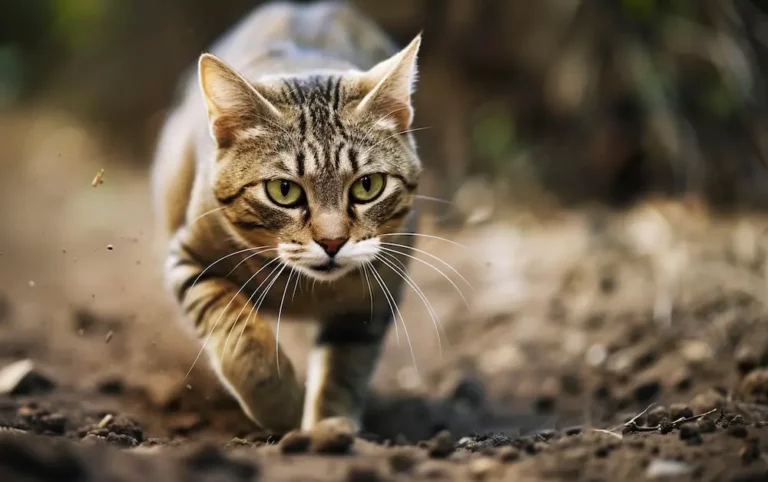Is Your Cat’s Loud Purring a Cry for Help? Here’s The Truth!
Ever wondered why your
While many associate a
Cats use purring as a form of communication, not just with humans but also with other cats.
Interestingly, some wild cats can purr too, though big cats like lions and tigers typically don’t.
The loudness of a
But, loud purring isn’t always about happiness.
It could be your
If you notice sudden changes in your
How Cats Produce the Purring Sound
Ever wondered how your
It’s fascinating.
Cats produce the purring sound by engaging their larynx and diaphragm muscles during both inhalation and exhalation.
This process involves several steps, which I’ll break down for you.
Diaphragm Contractions
Purring starts with rhythmic contractions of a
These contractions occur at a rate of about 25 to 150 vibrations per second.
The rapid pace is impressive and crucial for creating that continuous purr we all love.
Neural Oscillations
Next, the brain gets involved.
It sends neural oscillations—electrical signals—to the laryngeal muscles in the voice box or larynx.
When these muscles twitch rapidly, they cause the glottis (the space between the vocal cords) to open and close quickly.
Think of it as flicking a light switch on and off rapidly.
Airflow and Vocal Cord Vibration
As your
This action causes the vocal cords to open and close at a rapid pace, producing that characteristic purring sound.
The whole mechanism is like an intricate dance between muscles, nerves, and air.
Factors Influencing the Volume of Purring
Now that we’ve covered how cats produce that endearing purr, let’s talk about what influences its volume.
- Contentment and Happiness: Cats often purr loudly when they’re content or happy. You’ll notice it when they’re curled up in your lap with half-closed eyes.
- Stress and Anxiety: Surprisingly, cats may also purr more loudly if they’re stressed or anxious. It’s a self-soothing mechanism similar to humans humming to calm themselves down.
So next time your kitty purrs loudly, take a moment to observe them closely; are they relaxed or perhaps seeking comfort?
Reasons Why Cats Purr Loudly
When your
Expressing Contentment and Comfort
Cats often purr loudly when they’re content and comfortable.
You’ll notice this when you’re petting them or they’re nestled in their favorite spot. It’s one of the most common reasons for loud purring.
Ever seen your
Some cats have these naturally louder purrs due to genetic differences.
Their anatomy – specifically their larynx and vocal cords – can play a big part in how loud they get.
Purring is also a self-soothing mechanism for cats.
Just like people might hum or sigh, cats use their purrs to calm down and feel secure.
So, if you see your
Seeking Attention and Care
Loud purring isn’t just about feeling good; cats also use it to communicate with us.
When your
They’ve probably learned that this behavior gets them what they want – whether it’s petting, feeding time, or just some interaction.
Communication between mother cats and kittens relies heavily on purring.
Adult cats carry this form of communication into their interactions with us humans too.
Loud purring can be their way of saying “Hey, I’m here!†or “I need something.â€
Pay attention to other cues, such as head-butting or brushing against you; these typically accompany the loud purrs when seeking attention.
Indicating Pain or Discomfort
Though often associated with positive emotions, loud purring can sometimes indicate pain or discomfort.
If you’ve noticed sudden changes in your
Cats sometimes use loud purring to comfort themselves when they’re feeling unwell or anxious.
It’s similar to how we might groan when we’re hurting – it’s a way to cope.
Keep an eye out for any additional signs of distress like limping or unusual vocalizations.
In essence, understanding the context around your
Interpreting Your Cat ‘s Purring
Cats purr for various reasons, and understanding the context can help decode what they’re trying to communicate.
Let’s break down some common scenarios.
Signs of Happiness vs. Signs of Stress
Happiness in cats often shows through lower-pitched purring.
Ever noticed your
That’s pure comfort and happiness.
They might also give you a slow blink—the famous “cat kiss,” which screams affection and trust.
A relaxed posture, maybe even showing that fluffy belly, indicates they’re content and secure.
Seeing a tail held high with a slight curve? Yep, that’s another sign your kitty is happy and confident.
But not all purring signals contentment.
If you hear a higher-pitched purr, it could mean your
Panting while purring isn’t typical either—it’s usually a red flag for stress or discomfort.
When Loud Purring May Require a Vet Visit
Loud purring generally isn’t something to worry about; it’s often just your
But, if there’s a sudden change in how loudly or frequently they’re purring, paired with odd behaviors like hiding or refusing to eat, pay attention closely.
You see, each
Some cats naturally have louder purrs than others—it’s part of what makes them special!
But if you notice anything unusual alongside the loud purrs, such as changes in appetite or sleep patterns, it might be time for a vet visit.
In my experience as a vet, I’ve seen many cats use their loud purrs to mask pain or discomfort.
So if you’re ever in doubt about what those rumbles mean, consulting with your vet can provide peace of mind and ensure your
Conclusion
Understanding the nuances of your
Focusing to context and any accompanying behaviors you can interpret their emotional state more accurately.
Remember while loud purring often signifies joy or a desire for attention sudden changes in behavior may need a vet’s input. Each
Always trust your instincts and never hesitate to seek professional advice if something feels off.






